Mushrooms
Media
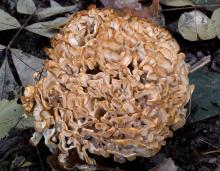
Species Types
Scientific Name
Sparassis spathulata (S. herbstii)
Description
The eastern cauliflower mushroom is a large, stalkless, whitish yellow rosette with flattened, wavy, ribbonlike folds. It grows singly, at the bases of trees and often at the base of decayed oak stumps.
Media

Species Types
Scientific Name
Phallus ravenelii
Description
Ravenel's stinkhorn is a long, whitish column with a greenish, smelly slime covering the top, and a whitish or pinkish cup around the base. It grows on wood debris, mulch, rotted stumps, and sawdust, and in deciduous woods.
Media
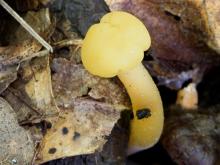
Species Types
Scientific Name
Leotia lubrica
Description
The jelly baby is a small mushroom with a gelatinous, orangish yellow stalk and head. It grows in groups on soil in mixed woods.
Media
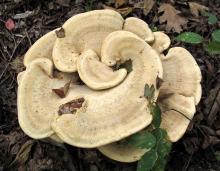
Species Types
Scientific Name
Bondarzewia berkeleyi
Description
Berkeley’s polypore grows in rosettes or clusters of fleshy, cream-colored caps, with whitish pores that descend the stalk. Look for them on the ground near the bases of trees.
Media

Species Types
Scientific Name
Tylopilus felleus
Description
The bitter bolete has a large, tannish brown cap with pinkish white pores and a webbed, tannish brown stalk. It grows singly or scattered on the ground in mixed woods.
Media
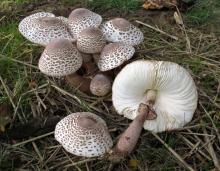
Species Types
Scientific Name
Leucoagaricus americanus (Lepiota americana)
Description
The reddening lepiota is a large, reddish brown mushroom with a scaly cap and a ring on the stalk; it bruises dark red. It grows singly or in clusters in mulch piles, waste areas, and around stumps.
Media
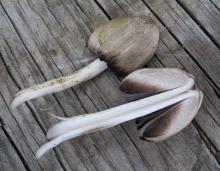
Species Types
Scientific Name
Coprinopsis atramentaria (formerly Coprinus atramentarius)
Description
The alcohol inky has a gray-brown, bell-shaped, radially lined cap and inky gills. It grows in clusters on the ground, usually near rotting or buried wood.
Media

Species Types
Scientific Name
Amanita spp. (about 600 species, worldwide)
Description
This large group of mushrooms accounts for 90 percent of mushroom-related deaths, so every mushroom hunter should be familiar with amanitas. They contain one of the deadliest poisons found in nature!
Media

Species Types
Scientific Name
Amanita rubescens
Description
The blusher has a tan to reddish brown cap with pinkish brown patches and a ring on the stalk; the entire mushroom bruises reddish. It grows on the ground in oak woods and under white pines.
Media

Species Types
Scientific Name
Laccaria laccata
Description
The common laccaria has a small, brownish pink cap with a central depression; the gills and stalk are a pale pinkish brown. Grows scattered or in groups in poor or sandy soil in mixed woods.
See Also



Media

Species Types
Scientific Name
Monotropa hypopitys
Description
Pinesap is a plant that puts the "wild" in wildflower! It lacks chlorophyll, so its roots connect to fungi underground and absorb nutrients from the fungi.
Media

Species Types
Scientific Name
Cladophora, Pithophora, and Spirogyra spp., and others
Description
Filamentous green algae forms green, cottony masses that are free-floating or attached to rocks, debris, or other plants.
Media

Species Types
Scientific Name
Monotropa uniflora
Description
Indian pipe lacks chlorophyll, so it is white, not green. Below ground, its roots join with fungi that connect to tree roots. This plant, then, takes nourishment indirectly from the trees.
About Mushrooms in Missouri
Mushrooms are a lot like plants, but they lack chlorophyll and have to take nutrients from other materials. Mushrooms are neither plants nor animals. They are in a different kingdom — the fungi. Fungi include the familiar mushroom-forming species, plus the yeasts, molds, smuts, and rusts.
Always be cautious when eating edible mushrooms. Be absolutely sure of the ID, and only eat a small amount the first time you try it to avoid a reaction..





















